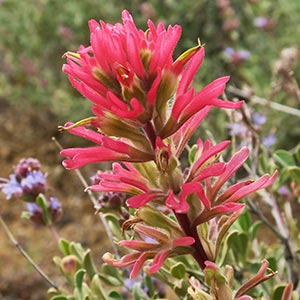Castilleja angustifolia
Castilleja elegans
narrow-leaf paintbrush, northwestern Indian paintbrush, northwestern paintbrush, violet desert paintbrush
elegant Indian paintbrush, elegant paintbrush
few to many, ascending to erect, branched, especially near base, sometimes unbranched, hairs sparse to dense, spreading to retrorse, long, sometimes short, soft to stiff, usually mixed with short-glandular ones, sometimes viscid.
few to several, ascending to erect, or slightly decumbent at base, unbranched, hairy, sometimes glabrate near base, hairs erect-ascending, whitish or yellowish, long, soft, eglandular, mixed with shorter stipitate-glandular ones, especially distally.
brown or purplish, sometimes green, linear to lanceolate or broadly lanceolate, 1.2–7(–7.5) cm, not fleshy, margins plane, sometimes ± wavy, involute or flat, (0–)3–5-lobed, rarely with secondary lobes, apex acuminate to rounded;
lobes spreading, oblong or lanceolate to linear-lanceolate, apex acute to rounded.
green to sometimes purple-tinged, lanceolate to narrowly oblong, (1.2–)2–6(–9) cm, not fleshy, margins plane, sometimes ± wavy, flat to ± involute, 0-lobed, sometimes 3-lobed distally, immediately below inflorescence, apex acuminate to caudate;
lobes ascending to erect, linear to lanceolate, lateral lobes narrower than central, apex acuminate.
2.5–20 × 1.5–5 cm;
bracts proximally greenish or dull purplish, distally pink, magenta, pink-purple, reddish pink, pale yellow, pale yellow-orange, pale orange, or white, rarely reddish or orange-red, lanceolate to oblong, 3–5(–9)-lobed, sometimes with secondary lobes;
lobes spreading or ascending, oblanceolate or linear, proximal lobes often much longer than distal, proximal lobes arising below or a little above mid length, apex acute to rounded.
1.5–9 × 1.5–3 cm;
bracts purple to pink-purple or reddish purple throughout, sometimes proximally purple to pink-purple or reddish purple, distally whitish or pale pink, oblong to lanceolate or narrowly ovate, (0–)3–7-lobed;
lobes spreading-ascending, linear-lanceolate, narrow, short or long, arising near or above mid length, center lobe apex rounded to sometimes acute, lateral ones acute.
straight, 18–27(–32) mm;
tube 8–17 mm;
beak usually long-exserted, adaxially green or pink, 8–15 mm;
abaxial lip deep green, reduced, inconspicuous, 1–2.5 mm, 5–20% as long as beak;
teeth incurved to ascending, deep green, 0.5–1.5 mm.
straight, 18–28 mm;
tube 17–20 mm;
abaxial lip generally visible between calyx lobes, sometimes exserted above them, beak exserted;
beak adaxially green, yellowish green, or purplish green, 4–8 mm;
abaxial lip purple or magenta, medium sized, often visible through or above abaxial cleft, pouches 3, slightly inflated, 3–5.5 mm, 50+% as long as beak;
teeth ascending, purple or magenta, 1–1.5 mm.
proximally green, yellow, brown, or purple, lobes colored as bract lobes, sometimes with a yellow band between proximal and distal parts, 13–25(–28) mm;
abaxial clefts 3–8 mm, adaxial 5–9(–12) mm, clefts 30–50% of calyx length, deeper than laterals, lateral (1–)1.5–4(–5) mm, 10–25% of calyx length;
lobes lanceolate to oblong, abaxials wider than adaxials, apex acute to rounded.
yellow to yellow-green, rarely purplish to dull red throughout, 19–25 mm;
abaxial and adaxial clefts 10–17 mm, 60–70% of calyx length, deeper than laterals, lateral (2–)5–8 mm, 20–25% of calyx length;
lobes narrowly oblong to lanceolate, apex rounded or obtuse, sometimes acute.
= 24.
Castilleja angustifolia
Castilleja elegans
Varieties 3 (3 in the flora).
Much confusion exists concerning Castilleja angustifolia and the closely related C. chromosa. Sometimes C. chromosa is treated as a variety of C. angustifolia, using the name C. angustifolia var. dubia. The latter name is used here to represent a different assemblage of plants, not including C. chromosa. At other times, C. chromosa is synonymized completely under C. angustifolia. However, the two species are in most cases easily separable, and where they are sympatric there is little evidence of intergradation. Both C. angustifolia var. dubia and C. chromosa are accepted here. See additional comments under 3b. C. angustifolia var. dubia and 15. C. chromosa.
(Discussion copyrighted by Flora of North America; reprinted with permission.)
Castilleja elegans is a characteristic species of the arctic and arctic-alpine regions. Its eastern and western limits are poorly understood, due to confusion with the similar species C. raupii to the east and south, and with C. rubra (Drobow) Rebristaya in eastern Asia. All three are part of a morphologically variable complex of recently evolved and poorly differentiated entities informally known as the C. pallida complex, after the first-described member of the group. Some reports of C. elegans in eastern Canada are here referred to C. septentrionalis. A recent collection of C. elegans from the northern Canadian Rocky Mountains is apparently disjunct, though it may also suggest its wider presence in Alberta.
(Discussion copyrighted by Flora of North America; reprinted with permission.)
1. Bracts distally usually pink to pink-purple; s Idaho, sw Montana, se Oregon, nw Wyoming. | var. angustifolia |
1. Bracts distally yellow, yellow-orange, pale orange, white, pink, reddish pink, or magenta; se Idaho, e Nevada, sw South Dakota, w Utah, ec Wyoming. | → 2 |
2. Bracts distally usually yellow to pale orange or white; ec Wyoming, adjacent sw South Dakota. | var. dubia |
2. Bracts distally usually yellow, yellow-orange, white, pink, or reddish pink; se Idaho, e Nevada, w Utah. | var. flavescens |


